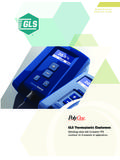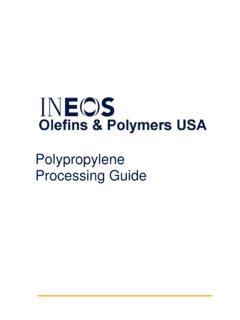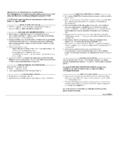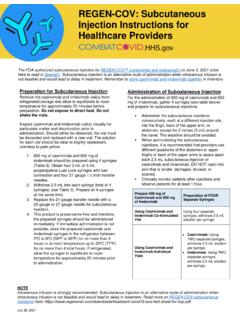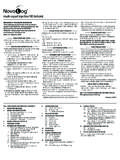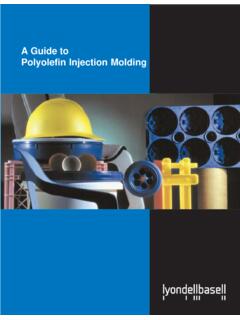Transcription of TOTAL TPE SOLUTIONS - Avient
1 TOTAL TPE SOLUTIONS 2004 GLS Corporation Rev. 082704 North American Headquarters833 Ridgeview Drive McHenry, Illinois 60050 phone1-800-457-8777 toll-free1-815-385-8533 faxemail: in The Netherlands and Hong Kong011 31 113 551 093 phone (Netherlands)011 (852) 2690 5330 phone (Hong Kong)1 IntroductionGLS is the recognized leader in the overmolding of thermoplastic elastomers(TPEs).Our overmold TPEs have excellent adhesion to a wide variety of substrates,from polyolefins, such as polypropylene and polyethylene, to engineering resins,such as PC, ABS, acetal and has developed several innovative technologies that have continued to setthe standard in overmolding.
2 Our overmolding product line includes a variety ofTPE technologies designed to deliver optimum adhesion to many engineeringplastics in both insert and two-shot molding working with GLS, you get the benefit of a world-classapplication development team spanning: Component design knowledge. Valuable tooling input. Creativity in molding process knowledge and material combinations. Compound development to meet specific application GLS Overmolding Guideis a comprehensive discussion of issues that arecritical to achieving high quality overmolded products.
3 This guide is a compilationof over thirteen years of experience in the development, design and processingof overmolding TPEs, based on contributions from a variety of GLS and industry of ContentsIntroduction1 Overmolding2 Material Selection4 Part and Mold Design6 Material Handling and Preparation17 TPE injection Molding18 Overmolding Processing Maximizing Adhesion21 TPE injection Molding Troubleshooting23 TPE Overmolding Troubleshooting28 Index3032 OvermoldingOvermolding is the injection molding process where one material (usually a TPE) is moldedonto a second material (typically a rigid plastic).
4 If properly selected, the overmolded TPE willform a strong bond with the plastic that is maintained in the end-use environment. The use of primers or adhesives is no longer required to achieve an optimum bond between thetwo can be used to enhance many features of product designs, including:Overmolding Process TypesTwo injection molding processes dominate the manufacture of overmolded products: insert moldingand multi-shot injection molding. Insert MoldingThe most widely used process is insertmolding, where a pre-molded insert isplaced into a mold and the TPE is shotdirectly over it (Figure 1).
5 For molders,the advantage of insert molding is that conventionalsingle shot IM machines can be used(new machinery expenditures are notnecessary), and the tooling costs associatedwith insert molding are lower than withmulti-shot processing. Multiple Material MoldingMultiple material, also known as two-shot(or multi-shot), molding requires a special injectionmolding machine that is equipped with two or more barrels, allowing two (or more) materials tobe shot into the same mold during the samemolding cycle. A molder will choose multi-shot molding to reduce cycle times, achieve superior part quality andreduce labor Mounted Replaceable InsertMagnetized to Hold Metal InsertTPE OvermoldSubstrateFigure 1.
6 Spring-loaded insert for metal Functionality Improved grip in dry Increase in comfort level. Water resistant wet environments. Sound absorption. Vibration damping. Electrical Process SelectionA processor will weigh numerous factors when choosing the appropriate manufacturing methodfor the application. The most critical decision factors are production scale economics, local laborcosts, available equipment and the materials selected. Generally, insert molding is the process of choice when annual production volumes and local laborcosts are low.
7 For higher volume production programs (over 250,000 units annually) or areas withincreased labor costs, multi-shot molding operations are the method of any overmolding application, the challenge is in achieving maximum adhesion between theTPE and the substrate. For some overmolding TPEs, there may be a significant difference in bondstrength between multi-shot and insert molding. Even if an excellent bond is achieved with two-shotmolding, the samematerial may have poor bond strength when insert molded. Thus, a completeunderstanding of the TPEs, engineering plastics, and associated details about molding these materialsis essential to produce high-qualityfinished products.
8 54 Adhesion RequirementsWhen selecting a TPE for an overmolding application, the substrate type should be all GLS TPEs will bond to all types of substrates; for example, a Dynaflex TPE that bondsto polypropylene (PP) will not adhere to polycarbonate (PC). GLS offers a diverse product line of TPE compounds and alloys for overmolding onto a variety ofsubstrates. Most Dynaflex , Versaflex and Versalloy compounds are suitable for two-shot orinsert molding with a polypropylene (PP) as the insert or substrate. The GLS Overmolding TPEs (Versaflex and VersollanTM) are specially formulatedto bond to a variety of thermoplastics, including.
9 Polycarbonate (PC) Acrylonitrile Butadiene Styrene (ABS) PC/ABS Standard and Modified* Nylon 6, Nylon 6/6, Nylon 6,6,6 Copolyester Polystyrene (PS) High Impact Polystyrene (HIPS) PC/PETG Acetal (POM) Polyphenylene oxide (PPO) Alloys or blends of the above *Glass-filled, impact-modified, and/or heat-stabilized more information regarding specific overmolding TPEs and their corresponding substratematerials, please refer to the GLS Overmolding Product Selector SelectionThe most common word used to describe a soft touch overmold is feel but the termitself is very difficult to describe.
10 When a designer wants the product to feel grippy or squishy , what exactly does this mean in terms of material properties?Basically, the feel of a soft touch overmold is dependent upon a combination of materialproperties (hardness, modulus, and coefficient of friction), texture and the TPE wall EffectsWhen choosing a soft touch TPE, designers usually ask for the softest material available. Whatthey do not know is that the soft durometer of a TPE adds little value to the concept of cushion when the thickness of the TPE is below a certain point (typically > ").



